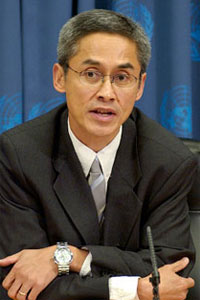
Cooperation between Europe and Asia offers much-needed opportunities to strengthen human rights education. The opportunities complement the global impetus to propel human rights education exemplified by various commitments in the recent past, ranging from the United Nations Decade for Human Rights Education to the World Programme for Human Rights Education and the UN Resolution on Human Rights Education and Training.
Now, new avenues for rights promotion have opened thanks to the 17 Sustainable Development Goals (SDG) 2015-2030, which have enjoyed universal "buy in" by all states, at least in principle. Significantly SDG 4 calls for inclusive, life-long quality education. A key component is global citizenship education, which includes human rights. SDG 4 also lays down various indicators to encourage systematisation and integration, particularly in regard to the need for a) national education policies, b) curricula, c) teacher education, and d) student assessment.
With this auspicious development, the current state of human rights education may be tested through the lens of these key entry points, inviting stronger responses from both regions.
Firstly, human rights education needs to start early, in pre-school and early childhood. This is a key period advocated by SDG 4, but the extent to which this group is exposed to rights education is not clear globally. Introducing human rights through good deeds and examples during this early phase of life is not necessarily difficult. Neither is it about establishing a specific course for children from 0-6 years of age. Rather, a sense of care and understanding for others can be nurtured through games, play and art that bring together children of different backgrounds and ethnicity to learn to be together and interact peacefully. A sense of equality, non-discrimination, and gender sensibility should be promoted.
Secondly, human rights education at the primary and secondary levels of education is important. But we also need to tackle the following issues concurrently as daily life, human rights situations: discipline in the classroom, bullying, the overemphasis on duties rather than rights, teachers suffering from work overload and poor pay, lack of parental involvement, help needed for children from poor or marginalised communities, and the creeping environmental challenge. The message, therefore, is that human rights education should be integrated into the school and at home -- together. The formal side of such information-sharing and awareness-raising is already operating in many countries through civic education and/or emphasis on the laws.
In practical terms, however, it is important to strike a balance between rights and duties, and promote positive discipline without corporal punishment both at school and at home. Child participation based on child rights, for example, via Children's Committees at school can help to set the rules and enable peer-to-peer learning. Head teachers need to support staff well to do their tasks while the Ministry of Education has a special responsibility to access those who are disadvantaged.
Thirdly, human rights education at the university level is already quite extensive, with specific courses on the subject in many countries. But there remains a need to reach out to communities, where human rights implementation can be boosted through legal-advice clinics and people-to-people programmes. Many universities today offer specific courses on human rights or infuse them in other courses. This level of education offers the opportunity to be more technical and delve more deeply into the international human rights system, to compare local practices with international standards and to help elevate national implementation to universal norms, bearing in mind local wisdom. Yet, the intellectual factor needs to be balanced with the empathy factor, particularly by connecting with ground realities.
Fourthly, human rights education beyond the primary, secondary and tertiary, through non-formal education is welcome, but the extent of outreach and the quality vary, and there is little impact assessment in the long term to see whether there are attitude and behavioural changes in the mindset and conduct of students/trainees. There needs to be more discussion on the quality and sustainability of non-formal programmes. Are they ad hoc or are they integrated into a sustained programme? Educating government officials must entail integrating human rights into their training, some budget for which should come from the state rather than from outside contributors, so as to ensure systematisation. Another challenge is how to track trainees in the long term to see what they do with the knowledge and whether the training has really impacted upon them. At least, with good planning, the follow-up can be attempted.
Finally, there is a need to promote participation and and critical analysis among learners. However, classrooms are often undemocratic and student participation is limited by lectures and learning-by-rote that undervalues real-life situations in favour of dry information. Also needed is a political space that encourages academic freedom and the teaching/learning process. This is particularly precarious in non-democratic states. They are more likely to favour economic rights, such as issues of food and livelihood, over a package of political rights such as freedom of expression and peaceful assembly -- " the bowl of rice" over the "basin of rights". They may also make questionable claims of relativism cum traditionalism, promoting a narrow interpretation of culture, values, gender and the family nexus. The challenge is not only to promote human rights but also democracy from the classroom upwards. To do so entails much-needed teacher training globally. There is the obvious need for plural sources of information which would help give learners a more critical view of what is being disseminated.
Vitit Muntarbhorn is a Professor Emeritus at the Faculty of Law, Chulalongkorn University. He was formerly UN Special Rapporteur, UN Independent Expert and member of UN Commissions of Inquiry on Human Rights. This article is derived from his recent address at the Informal Asia-Europe (ASEM) Seminar on Human Rights in Tromso, Norway.
